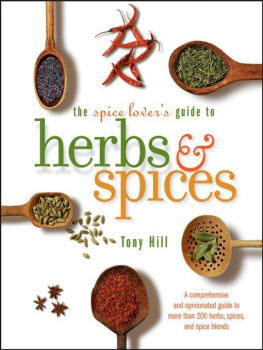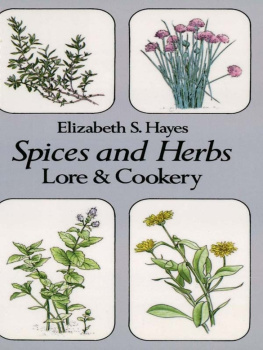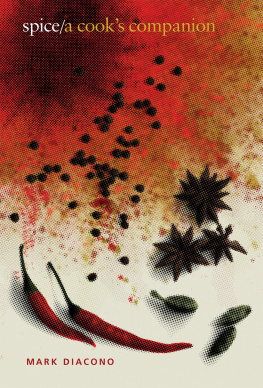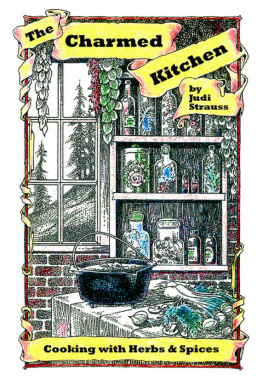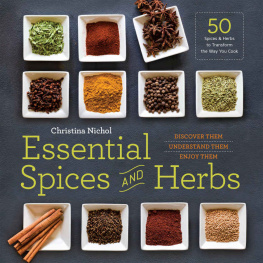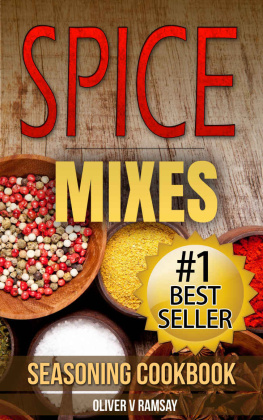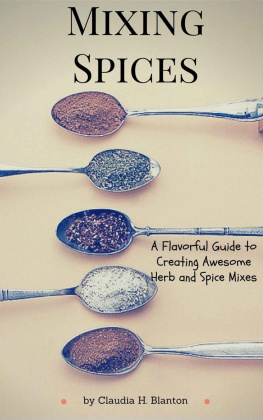Table of Contents
For Mom, Hobbes, and Cat (Theres salmon in it for all of you)
This book is printed on acid-free paper

Copyright 2004 by Tony Hill. All rights reserved
Originally published in hardcover as The Contemporary Encyclopedia of Herbs & Spices: Seasonings for the
Global Kitchen .
Published by arrangement with Tony Hill and becker&mayer!, Ltd. www.beckermayer.com.
Published by John Wiley & Sons, Inc., Hoboken, New Jersey
Published simultaneously in Canada
No part of this publication may be reproduced, stored in a retrieval system, or transmitted in any form or by any means, electronic, mechanical, photocopying, recording, scanning, or otherwise, except as permitted under Section 107 or 108 of the 1976 United States Copyright Act, without either the prior written permission of the Publisher, or authorization through payment of the appropriate per-copy fee to the Copyright Clearance Center, Inc., 222 Rosewood Drive, Danvers, MA 01923, (978)750-8400, fax (978)646-8600, or on the web at www.copyright.com. Requests to the Publisher for permission should be addressed to the Permissions Department, John Wiley & Sons, Inc., 111 River Street, Hoboken, NJ 07030, (201)748-6011, fax (201)748-6008, e-mail: permcoordinator@wiley.com.
Limit of Liability/Disclaimer of Warranty: While the publisher and author have used their best efforts in preparing this book, they make no representations or warranties with respect to the accuracy or completeness of the contents of this book and specifically disclaim any implied warranties of merchantability or fitness for a particular purpose. No warranty may be created or extended by sales representatives or written sales materials. The advice and strategies contained herein may not be suitable for your situation. You should consult with a professional where appropriate. Neither the publisher nor author shall be liable for any loss of profit or any other commercial damages, including but not limited to special, incidental, consequential, or other damages.
For general information on our other products and services or for technical support, please contact our Customer Care Department within the United States at 800-762-2974, outside the United States at (317)572-3993 or fax (317)572-4002.
Wiley also publishes its books in a variety of electronic formats. Some content that appears in print may not be available in electronic books. For more information about Wiley products, visit our web site at www.wiley.com.
Library of Congress Cataloging-in-Publication Data:
Hill, Tony
The spice lovers guide to herbs and spices / by Tony Hill. p. cm.
Includes bibliographical references and index.
ISBN-13: 978-0-764-59739-8 (pbk.)
ISBN-10: 0-764-59739-6 (pbk.)
ISBN-13: 978-0-471-21423-6 (cloth)
ISBN-10: 0-471-21423-X (cloth)
1. Cookery (Herbs) 2. Herbs I. Title.
TX819.H4H55 2005
641.657dc22
2005041622
Interior photography: WKDG Partners
Book design: Richard Oriolo
Cover design: Jeff Faust
Printed in the United States of America
10 9 8 7 6 5 4 3 2 1
PREFACE
Every culture in the world uses herbs and spices to enliven food and to create the culinary signature of its native land. Select seeds, leaves, roots, bark, flowers, and pods provide the special notes cooks summon up to make dishes sing. Combinations of seasonings create indelible patterns of taste tied to specific cuisines. Cumin and cilantro, for example, blend in a Latin beat. Ginger and star anise proclaim an Asian accent. And saffron and pimentn speak of Spain.
Because dining has become so global, with many cuisines fused to startling effect, herbs and spices are more sought after than ever before. Cooks have become culinary adventurers, bravely seeking out new foods from all over the globe. Foreign travel has introduced an incredible diversity of flavors, which, back home, dominate the contemporary dining experience. Star chefs, always on the lookout for the next hot trend, constantly experiment with exotic herbs, spices, and rubs. They mix their own blends, and like white-coated chemists, steep fragrant oils in glass jars, seeking yet another potent elixir to thrill their customers ever more sophisticated palates.
With all this experience comes a vast array of new ingredients. Cooks want to re-create the flavors of India, Thailand, and the Middle East. Where the spice rack once stood neatly stocked with European herbs and sweet spicesbasil, rosemary, oregano, thyme, cinnamon, clovesit now bulges with containers of less familiar items: fenugreek, tabil , lemongrass, and kaffir lime leaves. Luckily for the cook, the availability of these items has increased exponentially along with the demand.
Ive been a world traveler most of my adult life. Returning home from each trip, my bags laden with packets, jars, and bags of fragrant spices and other pungent ingredients, I would be compelled to re-create the exciting tastes I found abroad. What came next was an odyssey of discovery. Inspired by the romance of the past, I became a spice merchant, a modern-day Marco Polo of sorts, tramping all over the world in search of adventure and the knowledge that goes with the territory.
The history of the spice trade is filled with adventure, romance, and much peril. As early as the second century B.C., spices were the exclusive provenance of kings and the wealthy merchant class. Overland trade routes from Asian plantations to European cities financed empires perched along the way. More than five centuries ago, wars were waged over cargoes of cloves from the Banda Islands of Indonesia, and the English and Portuguese dueled over trading rights to nutmeg. And Malacca (Singapore today), a port poised at the gateway to the oceanic routes to Europe, was conquered some eleven times in two hundred years. It was the extraordinary profits from spice commerce that prodded Magellan, funded by the queen of Spain, to try so desperately to discover a way to sail around the globe.
Great caravans laden with cinnamon and peppercorns trekked across Asian deserts, unloading their precious wares in the port of Constantinople. From there, sailing ships carried the cargoes across the Mediterranean Sea to Venice, at that time the spice-trade capital of the world, where they commanded the most outrageous prices Europe had to offer. Andean chiles and Caribbean allspice were deposited right next to Aztec gold in the treasure vaults of Spanish conquistadores.
Marco Polo himself was motivated to travel to the East, lured in part by profits from the spice trade. Old World trading centers such as Istanbul became melting pots of culture and status, just as their kitchens blended spices and herbs in culinary masterpieces laced with the essence of far-flung cuisines.
The spice trade today continues to encircle the globe. Ive followed the same paths of discovery and adventurealas, without a sailing ship or a great Spanish queen as financial backer. Mastering the finesse of spicing techniques has been my goal. After years of roasting coriander, sifting rosemary, and grinding curry blends, I now happily offer my own considerable number of the tricks of the trade.
In fact, The Contemporary Encyclopedia of Herbs & Spices presents more than 125 pure herbs and spices, plus dozens of interesting blends. Here are botanical facts, information on buying and storing, and, most important, cooking uses for each listing. Recipes to accompany unusual seasonings pepper the book. Photographs help to identify all the herbs and spices as well as provide a glimpse into fields and harvests.

